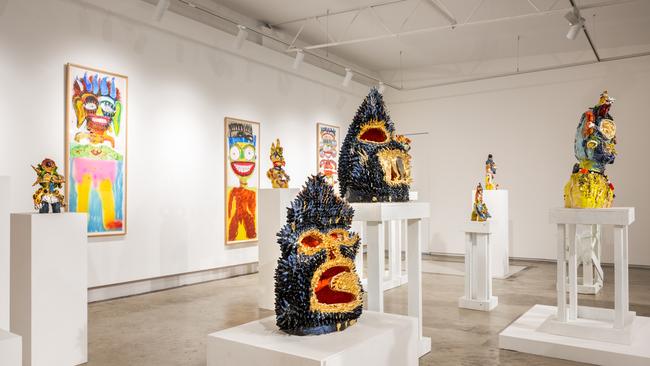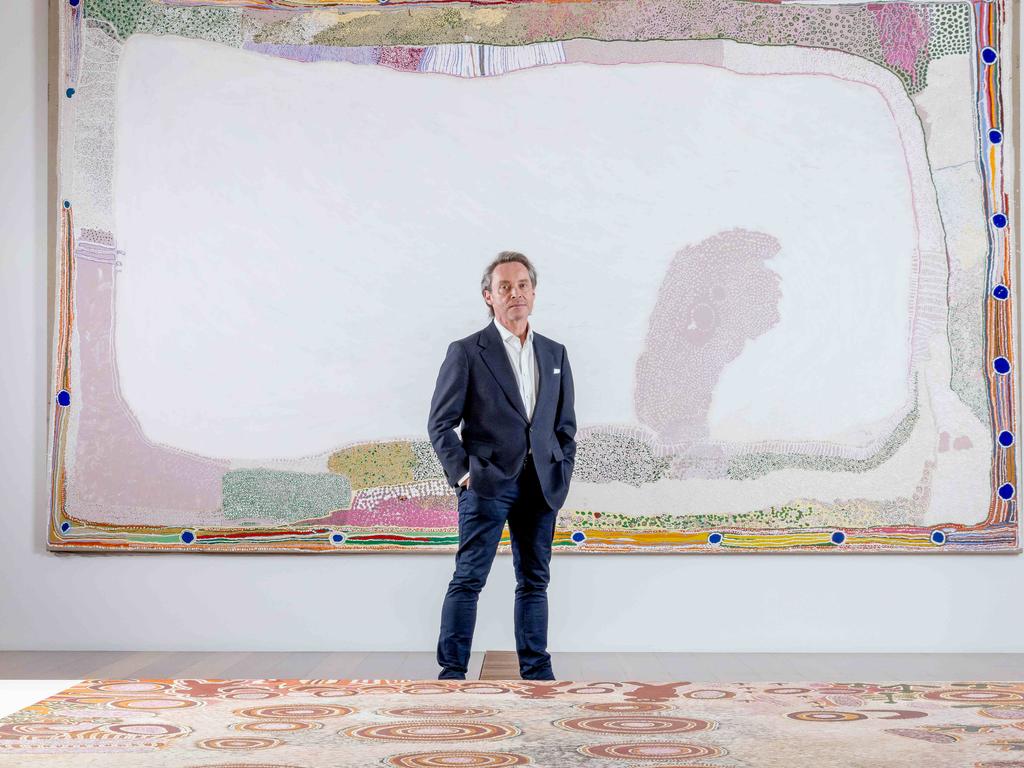The top mistakes people make when buying art, according to the experts
Don’t fall victim to purchasing a pricey piece you’ll soon regret. Here’s your guide to the art of buying art.

Despite many feeling the cost-of-living pinch, Sydney Contemporary’s recent run reported figures to the sum of $17.5 million in sales with a steady visitorship of 25,000 over the three-day art fair.
Investing in high-quality art has a thrilling allure to it but the journey toward collecting can be a daunting one. For the uninitiated, the art world is perceived to have a reputation of exclusivity and intrigue – making it easy to fall into hard-to-spot traps.
It seems there truly is an art to buying art.
Before first-time purchasers even begin to manoeuvre the world of buying art, there are a few things to know. To start, understand the key differences between buying through a gallery on the primary market, which tends to deal in selling new bodies of art by represented artists, and buying on the secondary market through auctions houses that resell art. Both markets come with their own quirks to navigate but “play an important role in the collecting journey”, says Dr Wiebke Brix, Head of Art at leading auction house Leonard Joel.
The art-buying journey can be a rewarding process to undertake for serious collectors as well as those who are just beginning their collections. You’re bound to find your dream art piece on the market. Just be sure to avoid the costly mistakes you don’t have to make.
Top mistakes people make when buying art
Overlooking important research
There is a great deal of art out there but not all of it is great. Gallerist Joanna Strumpf understands that better than most.
“It takes more than just one thing to make a good artist. If we’re talking about how to buy good art, there’s a lot of research involved,” says Strumpf, who is the co-director of leading contemporary art gallery Sullivan+Strumpf.
Failing to research an artist’s background, including their CV, is one of the most common mistakes hasty art buyers make. Not only could it leave you unsatisfied with the work you’ve chosen, but also with an overvalued investment that’s sure to leave a hole in the wallet.

If you’re looking on the secondary market, in particular, it is wise to request more information about an artwork’s provenance because this could be a key factor influencing its value. The provenance of an artwork will show you its recorded history of ownership, from when it was created to when it was last acquired. Having an understanding of this history – including its cultural significance and potential influence on other artists – will give you a better understanding of how much it’s worth. Consider where the artwork was originally purchased, whether it has been exhibited, and if it has been in a public institution.
Much like an artwork’s provenance, both Brix and Strumpf suggest there are key questions about artwork’s exhibition history buyers should investigate. As a starting point, look out for answers to the following:
- Is this artist being involved in important shows?
- Are they curated into group exhibitions?
- Are major museums acquiring their work?
- If they’re a newer artist, what’s their standout piece in an exhibition?
Put simply: if an artwork has been recognised in significant institutions, for example in a public gallery, it is likely to command higher prices. While this isn’t a fixed rule, a work that is culturally or historically significant will tend to hold greater value because more people are interested in owning it for the story it tells. This similarly applies to pieces of contemporary art. Even though these works may be relatively recent, ‘newness’ does not necessarily diminish the size of cultural impact. Be sure to ask an art dealer any further questions after you’ve completed your initial research.

Still unsure where to begin? Brix says art fairs, like Sydney Contemporary and the Melbourne Art Fair, are great places to acquaint yourself with key galleries and auction houses while building relationships with dealers you might like to buy from. When people plan to become collectors, they should focus on building strong professional connections with trusted dealers.
Strumpf says: “There’s an ongoing relationship that we have with our collectors in terms of valuations for their artworks, potential resale, and if we need to contact them to borrow artworks for exhibitions.”
Buying a piece of art you don’t really love
On the other hand, merely purchasing art for the sake of its investment value should never be the deciding factor that gets you over the line, particularly if you’re in the early stages of starting a collection. Rather, there is value in buying the piece of art you feel most drawn to.
“Because art is so personal, taste is a very important consideration that can’t be underestimated,” says Brix.
“Buying for only investment purposes is not ideal because markets are not always predictable. That’s why it’s important to buy art that deeply resonates with you. If you appreciate it, it will always remain valuable.”
Thinking higher price tags mean better value
Avoid purchasing a piece of art just because it seems everyone else is buying into the craze. It’s better to take a considered approach based on your taste and budget. Investing in art is a really rewarding journey, even for those who may be looking on the more affordable end.
“If you’re on a tighter budget, try to look at the major works by a slightly lesser known artist rather than reaching for a lesser piece by a more well-known artist,” says Strumpf.
While this approach may not always work out to be the best investment strategy, you will have a piece of art that will always resonate with you.
Brix adds that, on the other end of the spectrum, customers purchasing on the secondary market should remain vigilant of an artwork’s condition when considering its value.
“The artist might be great but is that artwork in a good condition? Creases or discoloration could lower the value of an artwork.”

Does this mean potential buyers should steer away from pieces that come from sought after collections just because of their condition? “Not at all,” says Brix, “the condition might not be perfect but the subject matter is very desirable. As long as you buy it at the right price it might still be worthwhile purchasing.”
Compromising on a purchase
The biggest mistake Strumpf sees is between couples who settle on a compromise piece.
“When one person is set on buying one work and the other is very set on another, they often end up settling for a work neither love.”
“If a couple is serious about investing, it’s best to take turns. This time they get the work they feel really passionately about, and the next you buy the work that you really love. That’s what ends up creating a really great art collection that you can’t stop looking at,” says Strumpf.
Making an impulsive purchase
“When it comes to purchasing art, spontaneity shouldn’t be lost. I will say, however, be very careful about buying art on holiday,” says Strumpf. “Cruise ships and beach resorts are often not the best places to find great art. These environments play on the fact that people are more relaxed when they’re on holidays.”
Rushing to buy an artwork without careful consideration lands many buyers in a state of regret. “If you have the time to research before you go to an exhibition opening where you think you might be persuaded to make an acquisition, that’s always a good thing,” says Strumpf.
Not following the right avenues to purchasing your art
Cutting out the middleman by communicating directly with the artist seems like a streamlined process, right? The rise of Instagram has certainly made it easier to reach out to artists to negotiate. However convenient this approach may be, it doesn’t always work to the artist’s benefit.
“It’s very easy to directly message an artist but it can put them in really difficult positions,” says Strumpf, “Generally, artists don’t want to be involved in the transaction; they have gallerists so they can focus on the creative side of things.”

It is worthwhile noting art dealers make a commission on every artwork they sell. Some artists, particularly up-and-coming ones, are unrepresented and will negotiate a sale directly with the buyer. If you’re looking at works by represented artists, the benefit of buying from a gallery is having the art dealer’s expertise on your buying journey.
While you should always stay informed by asking questions, a dealer can guarantee peace of mind in many instances. Gallerists should have all the essential credentials and documentation readily available for when you’re looking into an artwork. This information makes the process easier as it will be indicative of a work’s base value. Without seeking expert advice, a buyer may end up overpaying for their art and being stuck in a position where they cannot recoup the purchase price should they decide to sell.
Not staying up to date on market dynamics
If you’re on the market for new art, it’s important to stay on top of market trends in the art world. Many reputable auction houses will generally keep sales records on their websites.
“Pick a particular artist’s record to see how much their works have sold for previously, and look further back through their history,” says Brix.
These resources provide valuable insights into the price points artists’ works are selling for, helping you keep track of an art piece’s market value over time. Pro tip: look at other works in the same collection as the artwork you’re eyeing instead of earlier bodies, it may be a better indication of how much you should expect to pay.
Not prioritising the importance of sourcing art ethically
Failing to source art ethically is increasingly becoming a problem for collectors as it could jeopardise the authenticity and value of a work. While many gallerists are adapting to ensure their practices are ethical, buyers should remain observant. Read through any authentication documents that are handed over before you sign on the dotted line.
“When it comes to First Nations art in Australia, the art should always be accompanied by documentation linking the artwork to the artist via their community art centre or primary representative,” says Brix, “Our auction house turns down a huge percentage of works because, without the documentation, we cannot ensure these pieces [are not fakes] or being sold by art dealers who are paying the artist a lower price.”
Forgetting to take care of your art after its purchase
Investing in a new piece of art is an ongoing process – and one that requires a certain level of care. The buyer’s aim should be to maintain the same condition as when they purchased the artwork. Brix says art collectors should consider keeping artwork out of bright sunlight and safely store any works on paper that aren’t on display. If a piece of art is not adequately protected it may well depreciate over time.
If a buyer is unsure of these changes over time, a professional valuer or art consultant can be called in to assess the art.
“There are professional valuers who will come and give you a valuation, and if the work is in bad condition they’ll suggest the best course of action to be taken,” says Strumpf. “If there’s ever an inclination to resell the work they can also advise you on the best way to do that.”




To join the conversation, please log in. Don't have an account? Register
Join the conversation, you are commenting as Logout